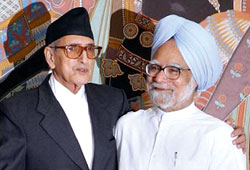 By the time this article is printed, innumerable column centimetres would have been expended discussing the PM's visit to India: how it was a sell out, how it compromised our integrity and sovereignty, etc. We have been doing this for the past 50 years and will continue to do so for another 50, or until we start seeing our neighbour in a new light.
By the time this article is printed, innumerable column centimetres would have been expended discussing the PM's visit to India: how it was a sell out, how it compromised our integrity and sovereignty, etc. We have been doing this for the past 50 years and will continue to do so for another 50, or until we start seeing our neighbour in a new light.
Let's start by examining our approach. We look to India the way a school kid approaches a parent for pocket money. In our eyes, every India visit is about our leaders carrying an empty jute bag across the border to be filled up. We never see India as a partner nation. We never think to tell its leaders: "You need energy desperately and we have plenty of hydropower. Let us see if we can work together." No, we want India to dole out projects as it does for Bhutan, but we want to keep our self-respect at the same time.
The fact that the prime minister's entourage does not include a water resources minister is actually a shock. In the past, we have negotiated refugee issues without having a foreign minister and look where that landed us. Fifteen years of mistakes but we do not want to learn from them. If tiny Laos can benefit from its powerful neighbour Thailand, why can't Nepal benefit from India?
Our fixed exchange rate and open border are to Nepal's advantage. The former lends stability to our macro-economic indicators but it will be interesting to watch how long India will want to keep theborder open. There is a potential for Nepal to become a Mexico to India's United States, with border fences and migrants risking their lives to cross over. Instead, we need to leverage the open border that allows the two nations' human resources to move freely. Remember, it was this border that absorbed the impact of the insurgency as thousands fled south in search of jobs and security.
If the world is now seeing India as a major partner in global growth, why is Nepal shy to elevate itself to partner status? Look at our advantages: the markets of north and northeast India are better served from Nepal than from India's south. We possess a young, educated workforce as the basis of our human capital and Nepal provides an easier transit to China than India's existing options. Why do we only look to India when we need to be bailed out, politically and economically, without taking into account our strengths and potential?
Rather than asking for cash handouts that would be chewed up in the cogwheels of the bureaucracy and shrouded by political cobwebs, it would be more profitable for Nepal to push Indians to invest here. Many millionaires south of our border are hungry for success and recognition. In today's India, a deal worth less than $100 million is not even noticed but an Indian entrepreneur with $10 million in his pocket can be a big wheeler-dealer in Nepal. We need to revise our laws and institutional framework to encourage such investments.
Instead of spitting venom about the great Indian design, isn't it time that we followed the rest of the world and started to build our partnership with India, and China? If we neglect this task and continue to brood over our shared past, future generations of Nepalis will not forgive us.



